Hummus
This post may contain affiliate links. Read my full disclosure policy.
Say goodbye to mediocre store-bought hummus—this authentic recipe delivers a creamy, flavor-packed dip, perfect for pita or as a standout on any Middle Eastern table.
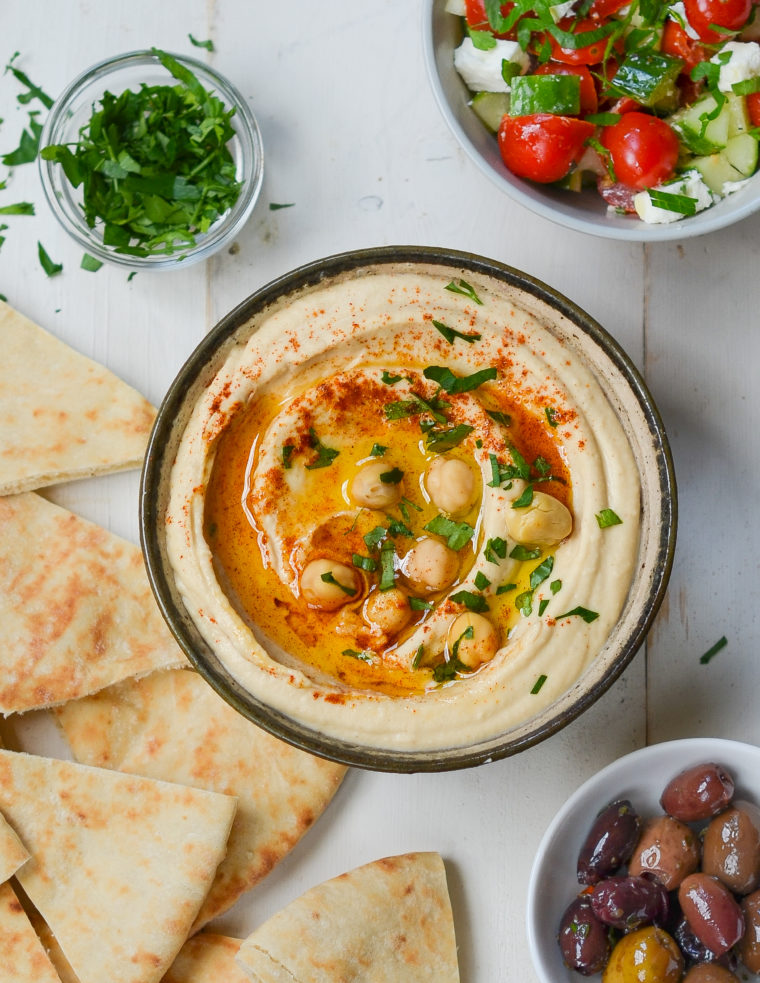
Hummus is a Middle Eastern spread made from a blend of chickpeas, tahini, lemon juice, olive oil, garlic, and spices. It’s commonly served as a starter or mezze, paired with pita bread, or as a side to dishes like falafel, kofta, Israeli salad, shakshuka, or chicken kabobs. I was fortunate enough to learn this authentic hummus recipe from a kabob maker in the Old City of Jerusalem. Using a few smart shortcuts I’ll share with you, it’s surprisingly easy to replicate at home.
So, why go to the effort of making homemade hummus when you can just grab a tub at the store? For starters, homemade hummus skips the soybean oil often found in store-bought varieties, staying true to traditional olive oil, and it swaps the artificial tang of citric acid with fresh lemon juice. Plus, no preservatives! Packed with protein and healthy fats, this homemade hummus recipe isn’t just healthier—it also delivers a flavor that’s miles ahead of anything you’ll find on the shelf.
Table of Contents
“This hummus recipe is FANTASTIC — the best I have ever had — and also ridiculously easy to make. No more store-bought hummus for me!”
What You’ll Need To Make Hummus
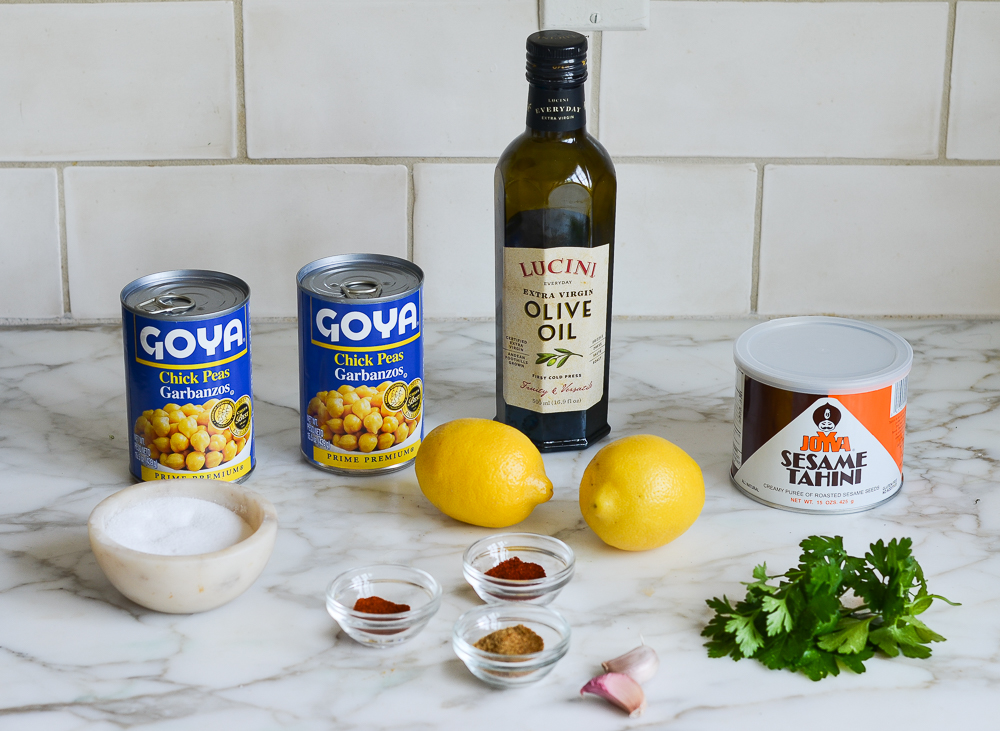
- Canned Chickpeas (also called Garbanzo beans): The base of the hummus, providing a smooth texture and a nutty flavor. While many hummus aficionados insist on using dried chickpeas that have been soaked for authenticity, I assure you, it’s not necessary. I’ve made hummus both ways and find there’s virtually no difference in the final product’s taste or texture. The convenience of canned chickpeas makes the process simpler and just as delicious.
- Lemon juice: Adds brightness and acidity.
- Sesame Tahini: Made from ground sesame seeds, tahini contributes a rich, nutty flavor and creamy texture. It is also used in other Middle East dishes, such as baba ghanoush, tahini sauce, and halva. You can find it in most supermarkets near the other nut butters.
- Garlic: Adds a pungent kick and depth of flavor.
- Ground Cumin and Cayenne Pepper: These spices provide earthiness and a slight heat, respectively.
- Extra-Virgin Olive Oil: Olive oil adds richness, smoothness, and a fruity aroma to the hummus. It also helps in blending the ingredients into a cohesive mixture. A drizzle of olive oil on top before serving also adds an extra layer of flavor and makes a gorgeous presentation.
- Paprika: Adds a pop of color and a subtle, smoky flavor. If you’re looking to switch things up, try sumac or za’atar instead. Sumac is a tangy, lemony spice made from dried and ground berries, which lends a bright, citrusy note. Za’atar is a Middle Eastern spice blend that typically includes thyme, sesame seeds, sumac, and salt.
- Jump to the printable recipe for precise measurements
Step-by-Step Instructions
Begin by draining the chickpeas in a colander (no need to rinse them). You’ll need to save the canning liquid for the recipe and set aside a few whole chickpeas for serving.
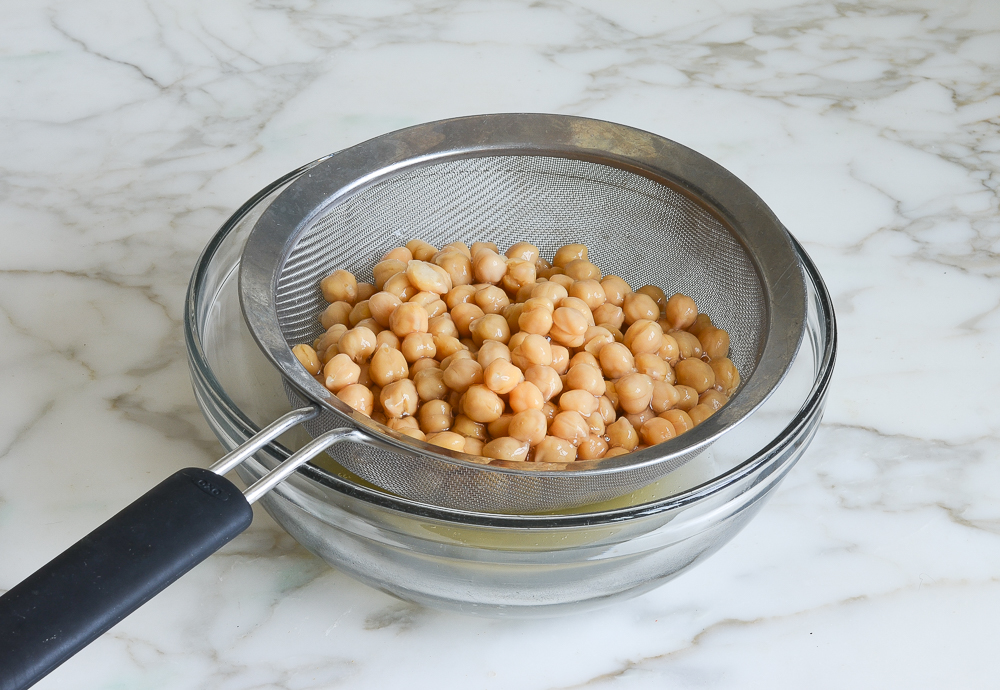
Next, combine the drained chickpeas, tahini, lemon juice, olive oil, garlic, salt, spices and 1/3 cup of the canning liquid in the bowl of a food processor. While a high-powered blender can also be used, you might need to stop and scrape down the sides more frequently, and it could take a bit longer to achieve the same smooth and creamy texture.
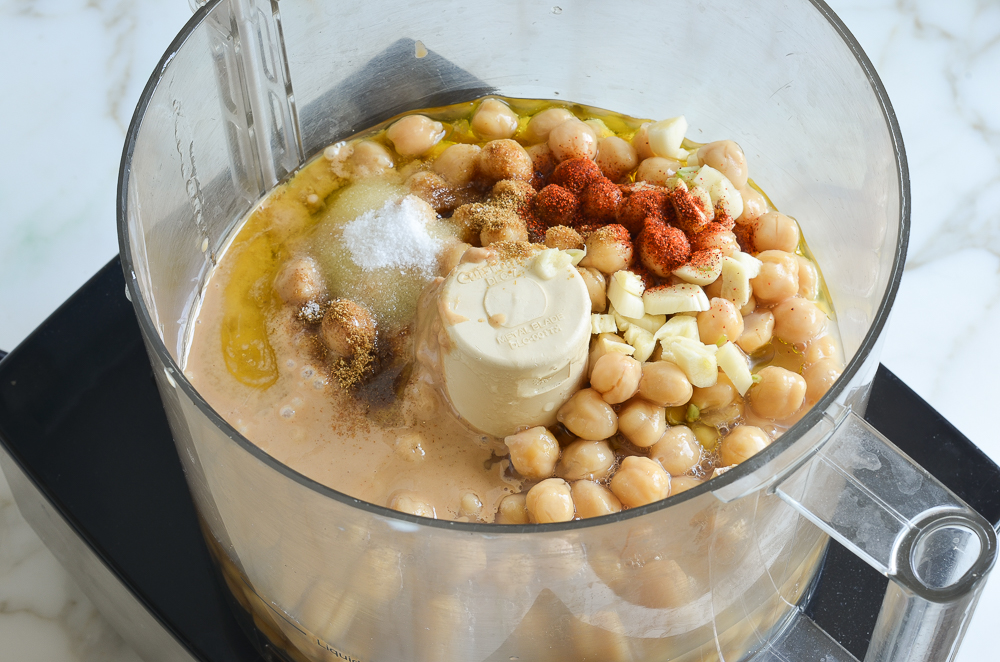
Blitz for a few minutes until smooth and creamy, adding more of the reserved liquid to thin the hummus if desired. The hummus should just hold its shape when you drag a spoon through it.
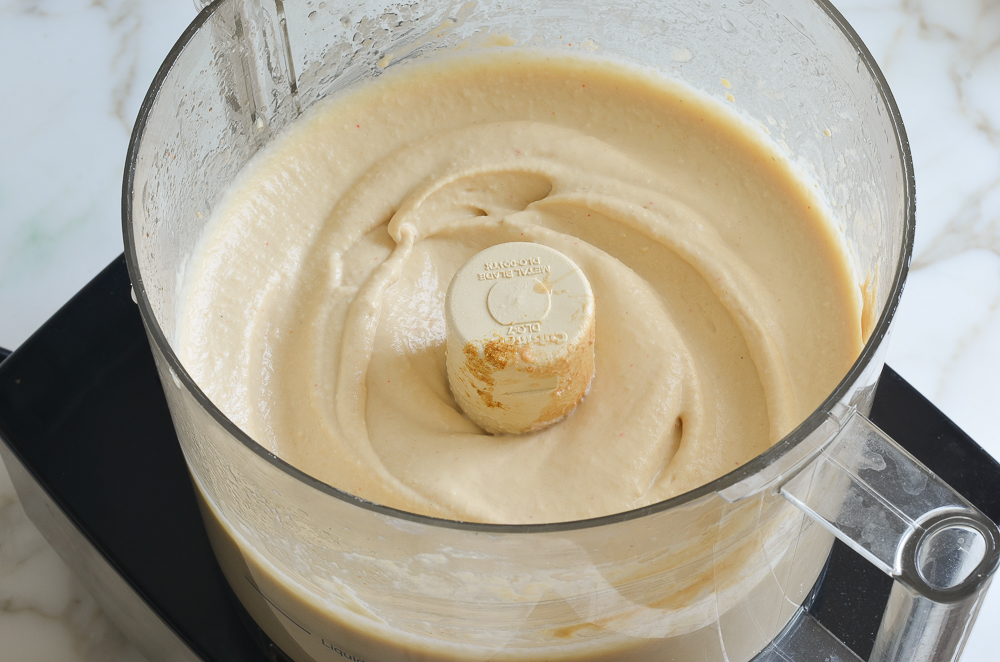
Transfer the dip to a bowl and use a spoon to form a shallow well in the center. Drizzle a bit of olive oil in the well, sprinkle with paprika and fresh parsley, and top with the reserved whole chickpeas. Serve with pita wedges, pita chips or crudités.
Make-Ahead Instructions
This hummus recipe can be made up to 2 days ahead of time and stored in a covered container in the refrigerator. Bring to room temperature before serving.
Frequently Asked Questions
I have seen recipes that call for peeling the chickpeas, supposedly because the skins prevent the hummus from getting super creamy. I tried it—it took forever, and I could not tell the difference. Keep it simple!
When you open a can of tahini, you will notice that the solids settle in the bottom the can, similar to natural peanut butter. It is very difficult to stir tahini in the can (the solids on the bottom are quite stiff) so I suggest scraping the entire contents of the can into a bowl, then using a whisk or hand-held electric mixer to blend. Place whatever tahini you don’t use back in the can and refrigerate until needed.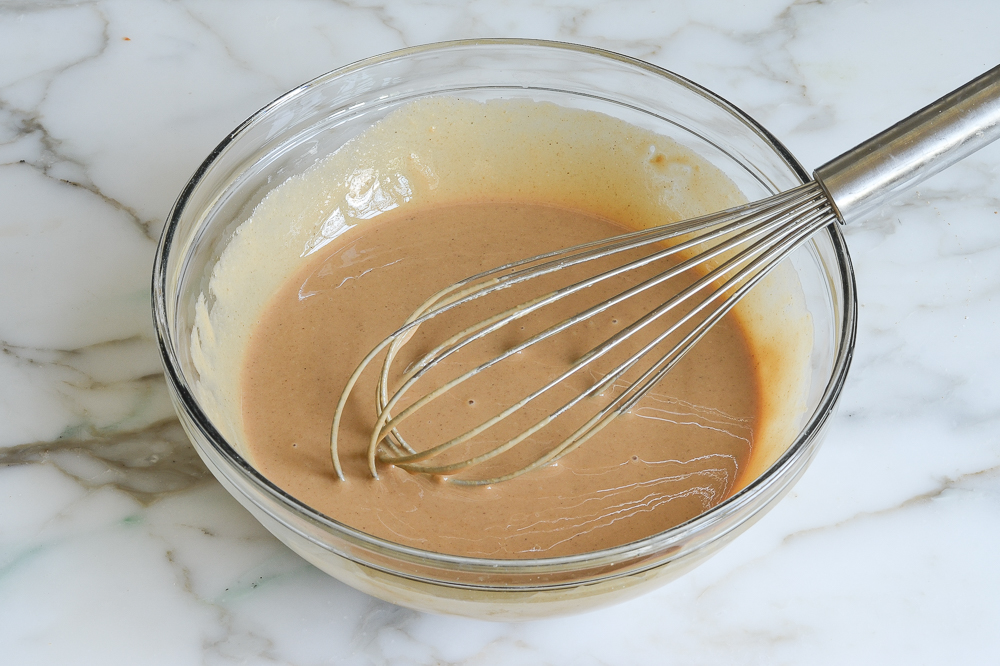
Video Tutorial
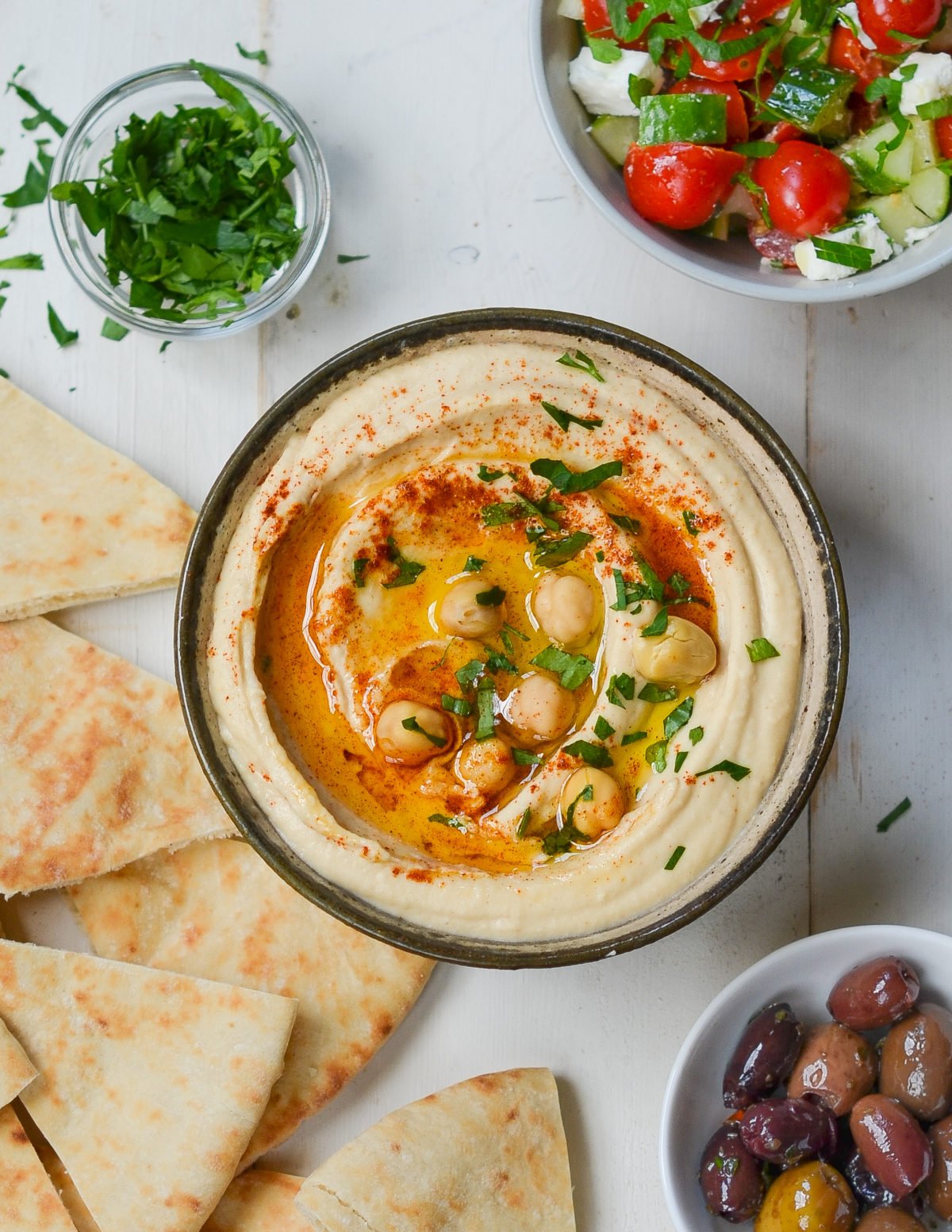
You May Also Like
Hummus
Say goodbye to mediocre store-bought hummus—this authentic recipe delivers a creamy, flavor-packed dip, perfect for pita or as a standout on any Middle Eastern table.
Ingredients
- 2 (15½ oz.) cans chickpeas
- ¼ cup freshly squeezed lemon juice, from 2 lemons
- ¼ cup sesame tahini, well stirred (preferably Joyva Sesame Tahini)
- 2 cloves garlic, roughly chopped
- Heaping ¼ teaspoon cumin
- ⅛ teaspoon cayenne pepper
- 1 teaspoon salt
- 3 tablespoons extra virgin olive oil, plus more for drizzling
- 1 tablespoon freshly chopped parsley, for serving (optional)
- Paprika, for serving (optional)
Instructions
- Reserving the liquid from the cans, drain the chickpeas in a colander (no need to rinse them). Set a few chickpeas aside for garnishing the hummus.
- In the bowl of a food processor fitted with metal blade, combine the chickpeas, lemon juice, tahini, garlic, cumin, cayenne pepper, salt, olive oil, and ⅓ cup of the reserved canning liquid. Process for several minutes until smooth and creamy. The hummus should hold its shape when you drag a spoon through it; add more liquid and process again if it seems too thick. Taste and add adjust seasoning, if necessary.
- Transfer the hummus to a serving bowl. Use the back of a spoon to swirl a shallow well in the center. Drizzle a little olive oil in the well; sprinkle with parsley and paprika, then garnish with the reserved chickpeas. Serve at room temperature with pita bread, pita chips or crudités.
- Make-Ahead Instructions: Hummus can be made and stored in a covered container in the refrigerator up to two days ahead of time. Bring to room temperature before serving.
Nutrition Information
Powered by ![]()
- Serving size: 1/4 cup
- Calories: 98
- Fat: 4 g
- Saturated fat: 1 g
- Carbohydrates: 12 g
- Sugar: 0
- Fiber: 4 g
- Protein: 5 g
- Sodium: 225 mg
- Cholesterol: 0
This website is written and produced for informational purposes only. I am not a certified nutritionist and the nutritional data on this site has not been evaluated or approved by a nutritionist or the Food and Drug Administration. Nutritional information is offered as a courtesy and should not be construed as a guarantee. The data is calculated through an online nutritional calculator, Edamam.com. Although I do my best to provide accurate nutritional information, these figures should be considered estimates only. Varying factors such as product types or brands purchased, natural fluctuations in fresh produce, and the way ingredients are processed change the effective nutritional information in any given recipe. Furthermore, different online calculators provide different results depending on their own nutrition fact sources and algorithms. To obtain the most accurate nutritional information in a given recipe, you should calculate the nutritional information with the actual ingredients used in your recipe, using your preferred nutrition calculator.
Gluten-Free Adaptable Note
To the best of my knowledge, all of the ingredients used in this recipe are gluten-free or widely available in gluten-free versions. There is hidden gluten in many foods; if you're following a gluten-free diet or cooking for someone with gluten allergies, always read the labels of your ingredients to verify that they are gluten-free.

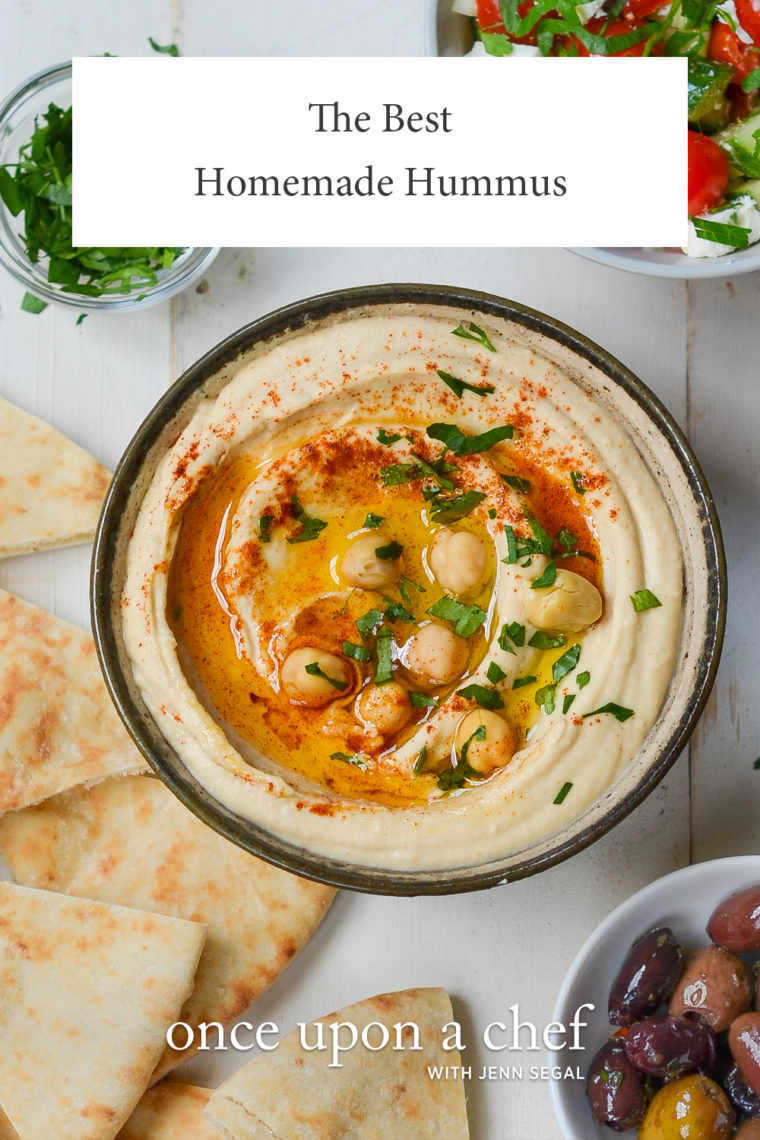
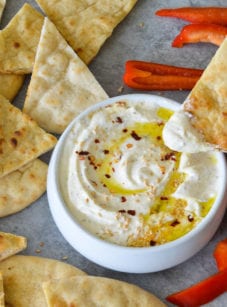
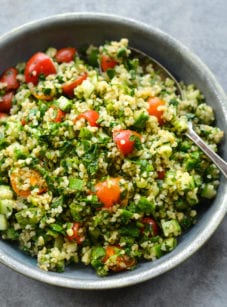
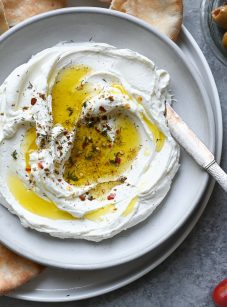
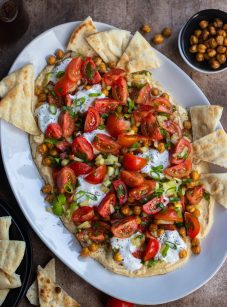
Only hummus recipe you will ever need! Spices are on point. So much tastier than store-bought. Thank you!
So good! I’m not a big fan of chickpeas so this is a perfect way for me to get them into my diet. This recipe is so fast and easy, less than 5 minutes to make. I’ll be making this again. Thank you!!
Hi Jenn, I can’t wait to try this recipe, but I don’t like the taste of cumin at all! Is there a substitute you recommend? Thank you for all of your delicious recipes!
Hi Mimi, It’s perfectly fine to just leave it out. Enjoy!
This hummus is FANTASTIC–the best I have ever had–and also ridiculously easy to make. No more store-bought hummus for me!
I am going to make it again but this time would like to add roasted garlic for a change. Jenn, any recommendations how much I should add?
Glad you like it! I’d add 2 to 3 roasted garlic cloves. I may suggest starting with 2 and you can always make it with 3 the next time if you’d like more of that garlicky flavor. 😊
Hello Jen, I have made your hummus recipe multiple times now and I feel like I’m not quite getting the best flavor. I use roasted garlic, but otherwise follow the recipe as written. As I live in Portugal, my choices for Tahini are limited. I use jarred chick peas that I put in the microwave for a few minutes with baking soda in order to remove the skin (I think the hummus has a better texture without the skins). What are your suggestions for “punching up” the flavor just a bit? More tahini? More cumin? Obrigada!
Hi Diane, I would start out by using fresh garlic instead of roasted ( when you roast it, it mutes the flavor). Also, the baking soda may have an impact on the overall flavor of the hummus. If you want to try punching it up a little, you could experiment with adding a little more garlic or lemon juice. Hope that helps!
We love this recipe and use it to make hummus regularly.
Recently I started buying garbonzo beans from the Palouse Brand website. It is a farm in Washington state. The taste is much better than any canned beans.
You have the best website on the internet and we recommend it frequently.
This hummus is the absolute best! I’ve made humus for 10 years all different ways and this recipe is the only one I follow now. It is perfect !
Delicious, never thought to keep the liquid from the Chick Peas before – worked well! I added one of my Hungarian Peppers and some parsley. Absolutely perfect. Served with a tomato/cucumber salad and grilled chicken. Sooooo good.
Nice recipe! I am on the fence about the chick pea skins: I usually drain the can, then pour the chickpeas onto a dish cloth, fold over and gently rub. Any skins that are loose, I pick out but don’t worry about the rest.
Yum! It freezes well, too. Thank you, Jenn.
Good to know. Thanks for taking the time to share that this can be frozen. I’m cooking for one.
This is very good. I’ve tried all kinds of hummus recipes, from using dried chickpeas soaking, not soaking, instant pot, boiling, and of course canned. Some say peel the skins, I agree with Jenn that it’s pointless (and labor intensive).
Jenn’s recipe has the right balance of all the flavorings. 1/4c of FRESH lemon juice is really key in this, and the only adjustment was I used closer to 1/2 cup of tahini based on other recipes that hailed it as a must for really tasty and smooth hummus.
I tried using roasted garlic (so good) which I thought was quite good.
The texture is fantastic and I really liked it.
Other recipes try things like whipping the lemon juice, tahini and aquafava together, so I tried that in the food processor before adding the chickpeas. Not sure if that made a difference or not but I tried it. I needed to add a little more liquid so I tried another tip from other recipes by adding ice cubes instead of water. Again, not sure if that did anything but the end result was definitely a hit.
This will be my go-to recipe, and buh-bye to dealing with dried beans and the instant pot!